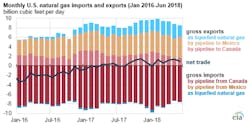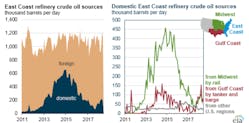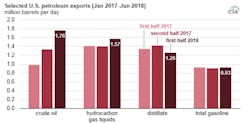Graphics courtesy of the U.S. Energy Information Administration (EIA)
US net natural gas exports in first half of 2018 more than doubled 2017 average
From January to June 2018, net natural gas exports in the U.S. average 0.87 billion cubic feet per day (Bcf/d), which more than doubled the average daily net exports during all of 2017, which amounted to 0.3 Bcf/d, according to data from the U.S. Energy Information Administration (EIA). This is due in part to the addition of new liquefied natural gas (LNG) facilities. Exports of LNG in the first half of 2018 rose 58 percent compared to the same period in 2017.
Natural gas pipeline import and export volumes remained flat or slightly declined from 2017 levels. Exports of natural gas by pipeline to Mexico increased 4 percent while exports by pipeline to Canada declined 14 percent. Eastbound flows on the TransCanada Mainline from western Canada increased by 0.26 Bcf/d from 2017 as tolls on the pipeline were lowered this year, according to data from Canada’s National Energy Board.
January was the only month so far in 2018 the U.S. was not a net exporter of natural gas. Prolonged low temperatures led to record demands for natural gas. U.S. imports from Canada in January average 9.25 Bcf/d — its highest level since January 2014. Monthly average U.S. LNG imports were higher this winter than in the previous two winters.
East Coast refiners receiving more domestic crude oil from Gulf
According to data from the EIA, the East Coast has been receiving as much crude oil by tanker and barge from the Gulf Coast as it has by rail from the Midwest since mid-2017. In April, the volume of crude oil transported by tanker and barge from the Gulf Coast to the East Coast reached the highest level since mid-2014. Crude oil shipped to the East Coast by rail from the Midwest has fallen 77 percent.
East Coast refiners traditionally imported crude oil from international sources due to limited pipeline infrastructure in the U.S. For East Coast refineries, the price difference between the international benchmark Brent and the domestic benchmark West Texas Intermediate (WTI) helps determine when the additional costs of acquiring and transporting domestic crude oil to the East Coast can be overcome.
The expansion of pipeline capacity increased the share in crude oil transported from the Midwest by pipeline from 64 percent of the region’s crude oil shipments in June 2015 to 87 percent in June 2018. East Coast refiners narrowed the Brent-WTI price spread by canceling or not renewing domestic crude oil supply contracts. EIA forecasted Brent will average around $6/b more than WTI in 2018 and in 2019.
Crude oil becomes largest US petroleum export in the first half of 2018
Crude oil topped hydrocarbon gas liquids (HGL) as the largest U.S. petroleum export, with 1.8 million barrel per day (b/d) in the first half of 2018. Exports increased by 787,000 b/d, or almost 80 percent, from the first half of 2017 to the first half of 2018. Much of this market went to Asia and Oceania. Europe was the second-largest export market.
In the first half of 2018, exports of crude oil, HGL and motor gasoline grew compared to the same period in 2017, while distillate exports decreased.
HGLs like propane, ethane, butanes and natural gasoline, followed crude oil as the second-largest petroleum export with 1.6 million b/d. Following HGL are distillate products and gasoline, respectively.
OPEC net oil export revenues continue upward trek
Members of the Organization of the Petroleum Exporting Countries (OPEC) received about $567 billion in net oil export revenues in 2017, up 29 percent from 2016. Increases in crude oil and net OPEC oil exports drove this revenue increase, and EIA forecasts revenues will continue to increase throughout 2018.
EIA predicts OPEC net oil export revenues will increase to $736 billion in 2018, up 30 percent from 2017. This prediction follows higher forecast of annual crude oil prices in 2018 and more than offsets slightly lower crude oil production from OPEC members in 2018. OPEC revenues will decline to $719 billion in 2019, according to EIA projections, driven mainly by lower crude oil prices.
Saudi Arabia receives more oil export revenue than any other member of OPEC, almost 30 percent of revenue in 2017. Iraq’s share has faced a notable increase, reaching more than 12 percent in 2017 and averaged 3.8 million b/d in 2017.






